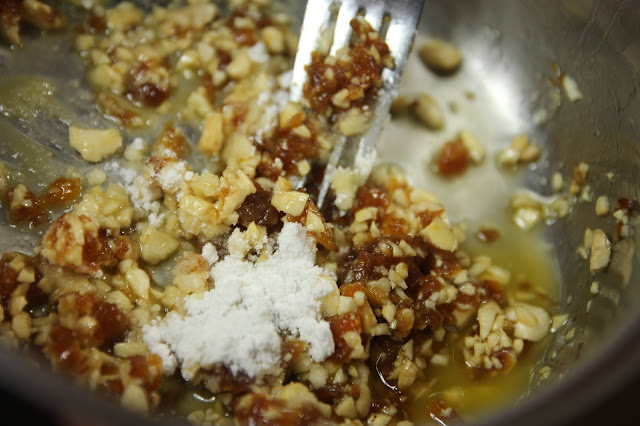Here's an alternative to my recent traditional Moroccan stuffed dates. This time I'm using cashew nuts and marrying them with apricots. I've also been able to obtain some organic raw butter. There has been a major problem with this in France for over a year, as demand is way outstripping supply. This has nothing to do with the 'butter crisis' which is happening in certain French supermarkets at the moment, that is to do with non-organic butter, which farmers are now exporting or selling directly through gate sales. I'm using half raw butter and half raw coconut oil, this is also a combination I use in chocolate truffles, a recipe which will be coming soon!

18 dates
25g - 1oz of raw butter
25g - 1oz of raw coconut oil
6 dried apricots
75g - 2½oz of chopped cashew nuts
60g - 2oz of powdered sugar
extra chopped cashews for decoration
Open the date wider using the thumbs.

I've chosen again the variety Deglet Noor to use in this recipe, which with its elegant tapered shape and soft translucent honey colour, well deserves its name; 'finger of light'.
This recipe would also be really good with Medjool dates but as they are much larger you are more likely to fill just 12 of the latter with this amount of mixture.
Dates are thought to be one of the oldest cultivated crops and interestingly enough for this gluten-free recipe, are often referred to as 'the Bread of the Desert'.
This recipe would also be really good with Medjool dates but as they are much larger you are more likely to fill just 12 of the latter with this amount of mixture.
Dates are thought to be one of the oldest cultivated crops and interestingly enough for this gluten-free recipe, are often referred to as 'the Bread of the Desert'.
INGREDIENTS
(makes 18 Stuffed Deglet Dates you will need to double the mix for large dates)18 dates
25g - 1oz of raw butter
25g - 1oz of raw coconut oil
6 dried apricots
75g - 2½oz of chopped cashew nuts
60g - 2oz of powdered sugar
extra chopped cashews for decoration
METHOD
Soak the apricots in warm water for a few minutes until they begin to plump up and soften. Chop them finely but reserve 18 thin slivers to decorate the dates.
With a sharp knife make an incision in the dates large enough to remove the pit.
Open the date wider using the thumbs.
Melt the butter and coconut oil remove from the heat and then add the finely chopped apricots and the roughly chopped cashews. Add the sugar and mix well.
Put the pan in cold water to get the butter and coconut to re-solidify.
Divide the mixture into 18 and using a teaspoon, stuff the dates.
Place them somewhere cool.
Enjoy!
All that needs to be said now is Bon Appėtit!
All the best,
Sue
Put the pan in cold water to get the butter and coconut to re-solidify.
Divide the mixture into 18 and using a teaspoon, stuff the dates.
Place them somewhere cool.
After a couple of hours press the dates more firmly together to make sure the filling is safely in place. Sprinkle with a few chopped cashews and serve immediately.
I have to say that this was once again absolutely delicious and I'm definitely going to make another version and this time with Medjool.
I have to say that this was once again absolutely delicious and I'm definitely going to make another version and this time with Medjool.
Enjoy!
All that needs to be said now is Bon Appėtit!
Hope to see you here again for another recipe from my 100 Gluten-Free Organic Party Foods Challenge!
All the best,
Sue
RELATED RECIPES
Pistachio Stuffed Dates. Gluten-free
The seventeenth recipe in my 100 Gluten-free Party Food Challenge. As well as being a festive dish, this recipe for stuffed dates is also an accompaniment for mint tea a fragrant and typically
Moroccan drink...read more
RETURN TO MAIN CONTENTS PAGE
RETURN TO 100 GLUTEN-FREE PARTY RECIPES CONTENTS
© Sue Cross 2017























































